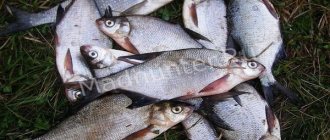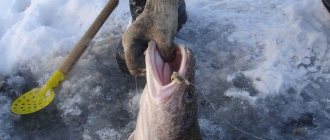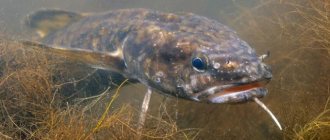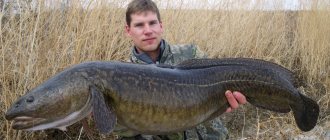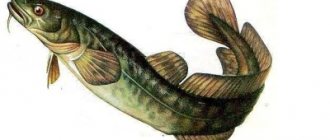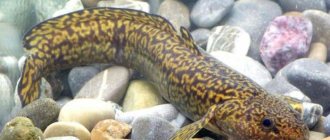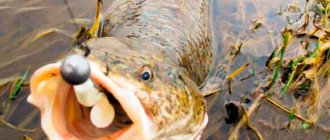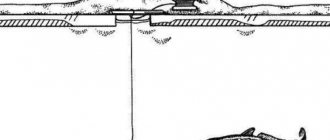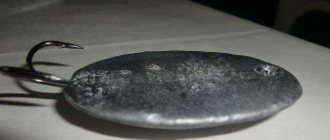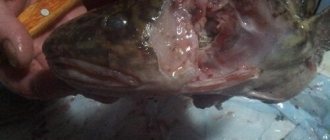These two large fish, which live in fresh running water, are sometimes confused by inexperienced fishermen and buyers due to their external similarity. Although they belong to different groups. Both one and the other have a mustache, a large body, the color is often dark, and the meat is white. The external similarity is due to the identical habitat and lifestyle of these predators.
What side dish do you prefer with seafood?
- Potatoes 30%, 318 votes
318 votes 30%318 votes - 30% of all votes
- Without garnish 25%, 257 votes
257 votes 25%
257 votes - 25% of all votes
- Fresh vegetables 21%, 222 votes
222 votes 21%
222 votes - 21% of all votes
- Stewed vegetables 15%, 154 votes
154 votes 15%
154 votes - 15% of all votes
- Cereals 9%, 96 votes
96 votes 9%
96 votes - 9% of all votes
Total votes: 1047
18.04.2020
×
You or from your IP have already voted.
But there are several main differences that help you understand the catfish or burbot in front of you:
- The first has a naked body, longer antennae (especially the upper pair) and more of them. The head is flattened, the fins are small.
- The burbot has a large antennae only on the lower jaw (even the beard is larger), and the fins are larger. The body is covered with small scales. The head is more elongated.
- The differences between these inhabitants of the depths are also in their maximum sizes. The first can grow up to three meters in length and weigh 200 kilograms. The second grows up to a meter, with a maximum weight of half a centner.
- There is also a difference in which parts of catfish and burbot are intended for cooking. Burbot, being a cod breed, is distinguished by its tasty liver, considered by many to be a delicacy. The meat is distinguished by its juiciness and slight sweetness in taste. For catfish, fillets are mainly used. There is a lot of meat in this fish, the bones are small, and the absence of scales helps with cleaning.
When purchasing any river fish, it is very important that it is as fresh as possible and definitely not frozen. Once defrosted, the meat of these fish becomes dry, stringy and tastes empty. This especially affects burbot.
FISH BURBT: DESCRIPTION
Almost all domestic experts agree that the burbot genus belongs to the “Lotidae Bonaparte” family, but scientists have not come to an unambiguous conclusion regarding polytypicity. Some scientists identify only a couple of subspecies. For example:
- Common burbot (Lota lota lota), which is considered a classic representative of reservoirs in Europe and Asia, including the Lena River bed.
- Slender-tailed burbot (Lota lota leptura), which inhabits the waters of Siberia, starting from the bed of the Kara River and ending with the waters of the Bering Strait, as well as including the Arctic coast of Alaska and up to the Mackenzie River.
The subspecies “Lota lota maculosa” lives in North America, which is considered controversial. The appearance of burbots, as well as their way of life, indicates that the fish has not undergone any major changes since the Ice Age.
Range and habitat
Burbot are found in fresh waters throughout North America, Europe and Asia, and their range extends south to about 40 degrees north latitude. They occupy the largest clear and glacial rivers and many lakes in most of Alaska. However, they are absent from southeast Alaska.
Facts about this species:
is the only freshwater representative of the cod family (Gadidae) in North America.
does not live in all bodies of water in the world; it is concentrated in certain areas of the planet with the most favorable conditions;
has excellent table quality and is often called the "poor man's lobster" in Alaska;
capable of reaching the age of 20 years or more.
it is the only freshwater species in Alaska that spawns under ice in winter.
All these features make the species unique, unlike most of its underwater relatives.
Structure of burbot
The body of the fish has an elongated shape, round in cross section, gradually narrowing towards the tail. River burbot is sometimes more runaway than its lake counterparts. The head of the fish is slightly flattened on top, and its size always exceeds the maximum thickness of the body.
There are two dorsal fins on the top of the body, the last of them is long, like the anal one. The rounded tail fits closely to them. The paired pectoral fins are located on the “throat”, the abdominal fins are lower. The second ones are larger in size than the first ones.
Appearance
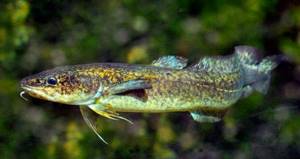
Burbots have a long but low body, rounded in the front and somewhat laterally compressed in the back. The head is slightly flattened and relatively long, and the eyes are very small. The mouth, on the contrary, is large in size, and the lower jaw is somewhat shorter than the upper. In the mouth you can see small, bristle-shaped teeth. There is one antennae on the chin, the length of which is approximately a fifth of the head. But on the upper jaw there is one pair of mustaches.
The color of burbot depends on the living conditions, which correspond to the characteristics of the soil, light and water transparency, including the age of the fish. Therefore, their colors can be very diverse. It is believed that the classic coloring of burbot consists of dark brown or blackish-gray shades, which lighten as the fish ages.
You can always see large light spots on the body of burbot, especially on the unpaired fins and on the sides. At the same time, the shape and size of the spots can be varied, but on the fins and on the belly their color is always light.
Burbots are characterized by the presence of two dorsal fins. As a rule, the first of them is short, and the second is longer than the first and significantly. The anal fin also has a certain length. Together with the dorsal fin, they come close to the caudal fin, but do not form one whole with it. The pectoral fins have a rounded shape. The pelvic fins are located in the throat area, in close proximity to the pectoral fins. The pelvic fin forms a second ray, which resembles a characteristic long thread consisting of sensory cells. The caudal fin has a characteristic rounded shape.
Interesting to know! The burbots of the Ob basin have the best rates of weight gain, as does the Vilyuya burbot. The largest burbot, reaching a weight of about 18 kilograms, is found in the Lena River.
The body of burbot is covered with cycloid scales of fairly small size, which are located almost over the entire surface of the body, including in the head area, right down to the gill cover and nostrils. The lateral line extends almost to the tail and further, but may be interrupted. It can grow up to 1.2 meters, and the growth rate largely depends on the availability of food in the reservoir.
Burbot
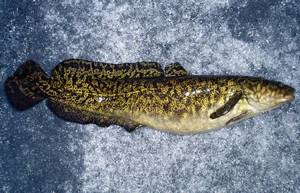
It is similar in appearance to a catfish, but differs from it in coloring and a longer dorsal fin. The body is covered with small scales, the skin secretes copious mucus. The mouth is wide, lined with very small, numerous teeth, like a brush, and the upper jaw is somewhat longer than the lower, the head is flattened, the upper jaw protrudes forward, and there is one antennae on the lower jaw. The color of the burbot's body depends on the nature of the soil, the transparency and illumination of the water, as well as the age of the fish, so it is quite varied: most often dark brown or blackish-gray, lighter with age. There are large light spots on the sides of the body and unpaired fins. The shape and size of the spots may vary. The two dorsal fins are also colored, the belly is gray or white, followed by a very long anal fin.
The body length can reach up to 120 cm. In different bodies of water, linear growth occurs differently. Thus, the burbot of the Ob basin is characterized by the best indicators of growth and body weight; the Vilyuy burbot is close to it in terms of linear growth rates. The largest individuals - up to 18 kg - were recorded in the Lena River.
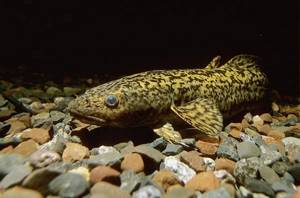
Burbot is more active in cold water. Spawning occurs in winter in December-February, the most successful fishing is at the first frost from dusk to dawn. The eggs are laid in portions on the ground. Burbot is the most prolific fish in our reservoirs: during spawning, one adult female can spawn up to three million eggs. But despite such fertility, it has not spread much across reservoirs, the whole point is that a very large part of the eggs, larvae and juveniles die, including becoming food for their older brother.
It feeds on invertebrates and small fish. May eat decaying animals. Caught on girders, especially loves ruffs. There are both sedentary (living in lakes and small rivers) and semi-anadromous forms (for example, burbot of the Ob River). Sedentary forms are usually small and slow-growing.
Semi-anadromous forms make long migrations (over a thousand kilometers per year). They have larger sizes (often more than a meter in length, weight more than 5-6 kg and age up to 15-24 years). Females do not spawn annually, skipping one or two seasons to restore the body’s energy reserves. Most males spawn annually.
Where does burbot live?
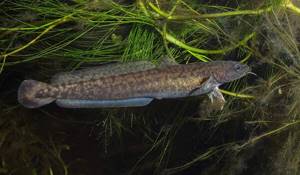
Photo: Burbot in Russia
Burbot prefers cold and clean reservoirs with a rocky bottom. Most often, this fish lives in deep holes with springs, in thickets of reeds and reeds located near the banks, as well as under snags and tree roots that go under water. It is these preferences that explain the fact that burbot most often disappears from rivers where trees growing along the banks are systematically cut down.
In central Russia, after the end of the flood (approximately May-early June), the period of sedentary life begins for burbot. The fish stop in steep ravines or huddle deeper into rocks and coastal burrows. In lakes, burbot is at its maximum depth at this time.
Moreover, he chooses to live either a place near underwater springs, or under floating shores. Burbot eagerly lives under rafts, adjacent to the ruff. Before the heat sets in, it still goes out to fatten at night (especially if there is a ruffe population nearby), but in July the fish huddle deeper into holes and under stones and snags. In the absence of natural shelters, it buries itself in the mud.
Taking into account all the factors listed above, the number of burbots is considered to be relatively small - and in the predominant territory of their range. There is a clear dependence - burbot are always found more often where the spawning grounds are on rocky soils and where nature provides the best shelters for the fry.
Now you know where burbot is found. Let's see what this fish eats.
Burbot and its properties
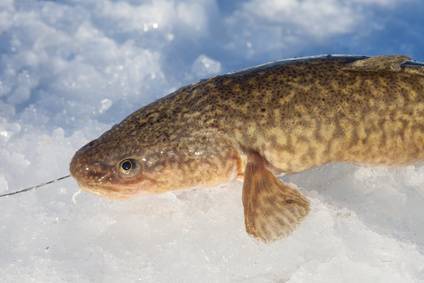
Regular consumption of burbot meat reduces the likelihood of heart and vascular disease and cholesterol levels. In addition, it helps to improve visual acuity and the condition of the skin and bones of the person who eats burbot. The burbot liver, which occupies up to ten percent of its weight, contains trace elements and healthy fats; adding it to the fish soup improves its taste and properties. Many northern peoples freeze burbot liver and then use it raw as stroganina. It is found in the basins of the White, Baltic, Black and Caspian seas, in rivers and lakes. Loves clean and fast northern rivers, cold water, rocky bottom. It is also found to the south, but when the water becomes warmer, more than twelve degrees Celsius, it goes to shady places, hides under snags, in holes, between piles, and in intertwined roots. During the day it hibernates, so village children, and even adult fishermen, catch it with their hands. He hunts when there is less light, preferably on a moonless night. Loves bad weather, and in rain and wind it bites well on the bait. Its ancestors lived in the cold northern seas, so it does not like the pelagic, that is, surface and subsurface waters, so it can be considered a bottom fish. At the same time, we must remember that he feeds there, and for example, using floating bait is quite problematic.
What does burbot eat?
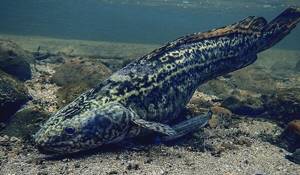
Photo: Burbot fish
The favorite delicacy of burbot are small minnows and fry of larger fish species that nest closer to the bottom. This fish will readily taste the long-fingered crayfish, but the population of these animals is rapidly declining due to the deterioration of the ecological condition of water bodies.
Burbot is also not averse to eating frogs, tadpoles, dragonfly larvae and other insects inhabiting freshwater bodies. Roach, crucian carp, perch and other freshwater fish that lead a diurnal lifestyle and swim mainly in the upper and middle layers of the reservoir rarely become prey for burbot.
An interesting feature is that the diet of burbot undergoes significant changes throughout the year. For example, in spring and summer, a bottom predator (at any age) gives preference to crayfish and worms that live on the bottom. On hot days, the fish goes hungry, preferring to “sleep off” at depth. Upon entering sexual maturity, burbot becomes a very dangerous predator - its “menu” can include fish that are up to 1/3 the length of its own body.
The predator's appetites increase in direct proportion to the decrease in water temperature and the reduction in daylight hours. In winter, the diet of burbot consists of minnows, ruffes and loaches, which lose their vigilance. But the sensitive crucian carp almost never falls into the mouth of a night predator. The autumn zhor lasts until the beginning of winter (about 3 months), with short intervals. With the onset of winter, the predator's appetite wanes.
Habits
The predatory fish is exclusively nocturnal. The senses (vision, touch, hearing, smell) are designed to search for prey in pitch darkness. Sunlight irritates the burbot's eyes, so during the day it does not hunt, but hides in the roots of trees, under stones, snags, crayfish holes and tries to take a position with its head facing outward. The same situation is observed with strong heating of the water, which causes many days of lethargy, apathy and loss of appetite. Only in cold and cloudy weather, when the temperature of the reservoir drops below +15°C, does the predator temporarily shed its summer torpor and show exceptional gluttony, often attacking filled fishing cages.
Another amazing habit of the burbot is its boundless interest in various sounds. Possessing exceptional hearing, the curious fish often travels considerable distances to determine the source of noise.
Fishing for burbot in winter and early spring
Burbot is active in colder water, so the best time to “hunt” for it is early spring, when nature slowly comes to life. It feeds almost exclusively at night. For these two reasons, it does not have many fans. We can say that only enthusiasts can catch it.
When planning a fishing trip, you need to look for a pond with a bottom that is not dirty, but also not covered with smooth pebbles. The best bottom is one with various types of damage, such as sunken trees, submerged roots or bushes, bridge pillars, etc. Fish choose such places both for shelter and in search of food.
Sources:
https://udimribu.ru/books/item/f00/s00/z0000011/st025.shtml https://moreprodukt.info/redkie/kak-otlichit-soma-ot-nalima https://zen.yandex.ru/ media/id/5d4d252ae6cb9b00ad8ff4d5/5df33afea3f6e400b2df359d https://eda.ru/media/produkt/nalim https://ribxoz.ru/ryba-nalim/
Features of spawning
The exclusivity of the cold-loving predator directly affects the timing of egg laying. Depending on the region and the specific habitat of burbot, spawning occurs between late December and February. In order for the eggs to develop properly, the water temperature must be +1°C. In northern latitudes, such conditions are created quickly by nature and last for several months. In the temperate zone, this is much more difficult, so the fish have developed the ability for parthenogenesis (“virgin reproduction”) - the full development of an unfertilized clutch. This amazing quality allows females to successfully solve the problem of procreation on rare days of sharp cold weather, without spending extra time searching for sexually mature males.
Burbot spawning occurs in shallow water areas with a slow current and a hard bottom: stone, shells, pebbles, sand. To do this, the fish makes long migrations, often to the places where it was born. The first to arrive at the spawning ground are large individuals, which lay eggs in small groups of 15-20 pieces. Then the medium-sized specimens also begin spawning in small flocks. The last to arrive are sexually mature young animals (3-5 years old), which gather together in noisy “companies” of 50-100 pieces.
Unlike other freshwater fish, cod eggs have good buoyancy due to the oily coating, so part of the clutch drifts freely and is transported by the current to areas of the reservoir with different microclimate conditions, which increases the chances of survival of the genus.
During spawning, the predator actively feeds, so in regions with a limited population there is a partial or complete ban on winter fishing.
Spawning
The fish reaches sexual maturity at 3–4 years of age. From this period, he begins to take an active part in procreation. His zhor begins at the end of autumn and lasts almost three months. Moreover, in December-January the predator makes spawning migrations. In rivers it moves upstream to shallow areas. The burbot in the lake is also moving from the depths closer to the shore. Here he selects areas with a sandy and rocky bottom, where he then spawns. The spawning process itself begins at the end of January at a water temperature of about 1–2 degrees. Large individuals begin spawning first, then young fish follow.
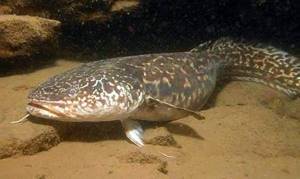
Burbot is a prolific predator. During spawning, the female of this predator can lay up to a million eggs. The burbot caviar itself has a yellowish tint and does not exceed 1 mm in diameter. This fertility of fish is associated with the spawning period, when other fish do not migrate through the reservoir and feed. Especially burbot eggs are eaten by the ubiquitous perch, cheeky ruff and gudgeon. A large number of eggs helps in the survival of the population of this cod species.
What is the difference between burbot and catfish
Quite often, inexperienced fishermen confuse burbot and catfish. These are two completely different fish, although they also have common features. For those who want to fish on their own or be able to differentiate when purchasing, it is important to know the differences. Burbot is similar to catfish in that it also has antennae, is an exclusively freshwater species, and has a similar body and head shape. But burbot differs in some nuances:
- he has a peculiarity - a mustache on his chin;
- the mustache above the upper jaw is 2–3 times smaller;
- body length is a maximum of 1.5–1.7 m, and the catfish can grow longer;
- the maximum weight is also less;
- The color of the burbot's skin is many times lighter and there are spots on it.
The taste is also different - catfish is fattier, its fillet gives off the smell and taste of mud. His behavioral characteristics are also different. Burbot is an active fish that, even in winter, continues to lead its usual lifestyle. Catfish are most active only in summer, from May to June. He spends the rest of the time at depth, burrowing into sand and silt, hiding in snags and depressions, where there is at least some living creature that he can use as food.
Composition and calorie content
The rich chemical composition of this fish is the reason for its popularity. The presence of a huge amount of useful substances in burbot is the basis for the properties of this product. It is important to know what this product contains. This will help you decide whether to include it in your diet or replace it with some other type of fish. Researchers have identified the following valuable substances in burbot:
- iron, manganese, molybdenum, copper, zinc, selenium;
- unsaturated and polyunsaturated fatty acids;
- sterols (beneficial cholesterol, which takes part in cell division);
- retinol and vitamin E;
- phosphorus, calcium, potassium, sulfur, sodium, magnesium;
- cobalamin, folates, vitamin PP;
- pantothenic acid;
- thiamine, pyridoxine, riboflavin;
- amino acids.
In terms of its composition, this fish is not inferior to many vitamin and mineral preparations used in the treatment of nutritional deficiencies. But the product has an advantage that makes it more valuable than tablets - it is completely absorbed by the body and has no side effects. The calorie content of burbot is from 80 to 90 kcal, depending on age and habitat. The larger the fish, the more fat it contains, which increases its nutritional value.
When and how best to catch
You can catch burbot at any time of the year. But the best time is winter.
The following equipment must be used:
- gudgeon;
- goby;
- frozen perch;
- worms;
- frogs;
- crayfish;
- dead fish.
For the best results, it is good to cook frogs, minnows or ruffs at the fishing spot. The burbot's favorite delicacy is dead fish.
In the summer, it is almost impossible to catch burbot, since it does not like warm water and hides, but for fishing it must be at night. They prefer different foods in each season of the year. In accordance with this, any bait is used, but live or dead fish are better.
Eating
Meat - nutritional and beneficial properties. Liver is a delicacy. These are vitamins of group A, B, C, D, E. But the fish must be boiled, then it will release these beneficial substances. Iodine, magnesium, calcium, zinc, protein, amino acids and much more will be received by those who eat burbot.
You should not eat burbot if the diagnosis includes the presence of stones in the kidneys or gall bladder; the body is rich in calcium and vitamin D.
What can you cook from burbot meat? Each housewife has her own recipe for preparing this fish.
- Baking in the oven. Burbot meat goes well with onions, dill and parsley, baked tomatoes and aromatic spices. After sprinkling with lemon juice, the dish is left for 30 minutes at a temperature of 180 degrees.
- Burbot soup. Green vegetables and shredded liver will give you an unforgettable aroma and pleasant taste sensations.
- Burbot meat cutlets. A rather interesting combination of products in this dish will delight everyone who gets it. The minced meat includes pure meat, cheese, milk and rice.
If children eat burbot fish at least once a week, their brain activity and academic performance will significantly increase. Twice. In addition, visual-spatial orientation and speech ability will improve. And these are the recommendations of Swedish scientists.
We suggest you read: Fishing in Kuzkino, Belgorod region
Now every fisherman is familiar with how to catch such fish as the largest burbot. Choose the right bait, time of year and eat only after heat treatment. Happy fishing!
Behavior and lifestyle

The uniqueness of this fish lies in the fact that burbot shows its greatest activity in cold water, while its spawning takes place in conditions when there are December and January frosts outside. Therefore, we can safely say that the peak of burbot activity occurs in winter. This predator prefers to lead a bottom-dwelling lifestyle and goes out hunting exclusively in the dark.
Burbot and its varieties feel comfortable in conditions where the water temperature does not exceed +11.5 degrees. When the water in a reservoir warms up to a higher temperature, the burbot becomes inactive or falls into a state of suspended animation.
Although burbot is not a schooling fish species, a school of burbot consisting of several dozen individuals can easily be found. As a rule, this is typical for smaller individuals, and trophy specimens stay apart. With the onset of warmth, burbot begin to seek shelter for themselves, hiding in holes or among piles of stones.
Interesting fact! Adult burbots are capable of not feeding for a long period.
This fish chooses for its camping places where there are cold springs. In addition, this fish does not tolerate light, so it feels uncomfortable even on moonlit nights. With the onset of heat, burbots stop feeding completely and go hunting when periods of cold weather occur, and then only at night.
Burbot fishing
In order to ensure a good catch, it is advisable to find a “burbot trail”, that is, those places where it makes sense to look for it. Burbot chooses not just cold, but also highly oxygenated waters; it can hardly be found in silted reservoirs. It takes well on both live and dead fish, although deviations from normal behavior are possible. The difficulty for the fisherman is the lack of a pronounced bite. Having swallowed the bait, the burbot remains in place, and sometimes you can only find out that the fish has been caught by pulling out the tackle. It must be taken into account that this fish has the ability to tightly wrap and tangle the fishing line, so to fish for it you need to use simple and strong tackle with a short and strong fishing line. The fish just needs to be pulled out without any tricks, the burbot will go in the direction of applying force to the line, but this is a persistent fish, so the process of getting it out of the water is not entirely simple.
Natural enemies of burbot
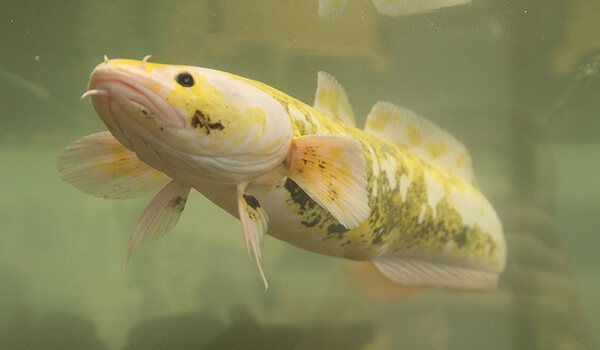
Photo: River fish burbot
The highest fertility of burbot does not make this fish breed numerous. In addition to the death of most fry during floods, a countless number of eggs are carried away by the current. In addition, other fish are not averse to eating burbot caviar (the main “baby killers” are perch, ruffe, roach, and, to a greater extent, the burbot’s “favorite” gudgeon). Ironically, part of the eggs remains in the bottom depressions and is eaten by the burbot itself. As a result, by the end of winter, no more than 10-20% of the countless eggs remain.
If you take an adult, sexually mature burbot, then it has a minimum of natural enemies. Few people dare to attack a fish 1 m long. The only thing is that in the summer (during the heat, which burbot, being a typical northern fish, cannot tolerate at all), when even adult burbot do not show much activity, it can become food for a catfish significantly larger in size.
The main danger lies in the hands of small and unborn burbots. It is for this reason that only a few burbots survive to the age of sexual maturity. Burbot caviar, by the way, is a “delicacy” for fish even in winter. But ruffes, silver bream and perches, as well as other fish that serve as food for mature burbots, like to feast on the fry.
Geography of burbot settlement
The cold-loving fish burbot cannot live in regions with a warm climate; its range covers rivers and reservoirs of the northern hemisphere. These include the rivers of the Arctic Ocean and Siberia: Northern Dvina, Yenisei, Khatanga, Pechera, Lena, Ob, Irtysh, Amur. The burbot habitat extends to the river basin. Anadyr, covering the northeastern borders of Russia. Burbot inhabit the waterways of the Baltic Sea and its lakes: Ladoga, Chudskoye, Onega, o. Ilmen.
Populations of small individuals are found in the upper reaches of the rivers of the Black and Caspian Seas; they are few and small in the Don and Kuban, no more than 0.5 - 0.8 kg.
In the British Isles and Belgium, Nm ceased to exist more than 40 years ago, as evidenced by its remains. In other European countries: Germany; the Netherlands; France; In Austria, where it is considered an endangered species, the situation is also grim. Stable numbers of burbot remain in Italy and Switzerland.
The cold rivers of Siberia and the Arctic Ocean, being the indigenous habitats of burbot, are considered the most favorable for its growth and reproduction. That is why here it reaches its largest size and record weight. It is most numerous in sections of small rivers flowing through lowland forests.
Population and species status
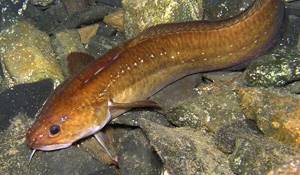
Photo: What burbot looks like
The range of burbot is quite wide - the fish is found in freshwater bodies of the northern regions of Europe, Asia and North America. In Europe, burbot is caught in New England (the fish is practically not found in Scotland and Ireland), in France (mainly in the Rhone River basin, somewhat less often in the upper reaches of the Seine and Loire), in Italy (mainly in the Po River), and also in the western cantons of Switzerland, in the Danube basin (almost everywhere) and in reservoirs belonging to the Baltic Sea basin. Not found (since the middle of the last century) on the west coast of the Scandinavian countries, as well as on the Iberian, Apennine and Balkan peninsulas.
In Russia, burbot is distributed everywhere - in reservoirs flowing in the Arctic and temperate zones, as well as in the river basins of Siberia - from the Ob to Anadyr, and throughout their entire length. In the European part of Russia, burbot is not found in the Crimea, Transcaucasia (with the exception of the lower reaches of the Kura and Sefidrud), sometimes this fish is caught in the North Caucasus - in the river basin. Kuban. The northern boundary of the range is the coast of the Arctic Ocean.
In the south, burbot is found in the Ob-Irtysh basin, and occupies a fairly wide range - starting from the upper reaches (Lake Teletskoye and Zaisan) and up to the Ob Bay. This fish is not found in Central Asia, although in the century before last this fish was actively fished in the Aral Sea basin. In the Yenisei and Baikal, burbot is caught almost everywhere. In the Selenga basin, the range descends to the south, all the way to Mongolia. Burbot is found throughout the river basin. The Amur River with its main tributaries - the Ussuri and Sungari. Found in the upper reaches of the Yalu River.
Regarding the Pacific coast, burbot is found on Sakhalin and the Shantar Islands, and even ends up in desalinated areas of the seas (where the water salinity does not exceed 12).
Where does burbot fish occur and live?
Burbot is a relict fish that came from the Ice Age. The most favorite places for this type of fish are the rivers of the Arctic Ocean. The largest species can be found here. Accordingly, the closer to the south, the smaller the fish. Burbot also swims in the rivers of Siberia, Ufa, Tura, Tavda, near the Ural slopes, and in lakes. In general, burbot lives off the northern coasts of Europe, Asia, and America. This is a fairly valuable commercial fish species. The most suitable temperature for life should not exceed +10 - +12 degrees.
Warm water leads to slow movement, the fish plays hide and seek and is difficult to find.
The mandatory rule of water for burbot cod fish is fresh water. Therefore, this list includes rivers in lowland areas, forests, and mountain rivers. The colder the better. During the summer period, it is almost impossible to catch, since even the lightening from the moon is perceived as a bright source of light. It eats extremely rarely in the heat, so it does not leave its “homes”.
Where to find it in warm weather:
- burrows;
- driftwood;
- tree roots;
- grass.
Protection of burbot
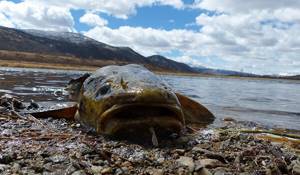
Photo: Burbot from the Red Book
Burbot belongs to the 1st category of extinction - the species is under threat of extinction within the boundaries of Moscow, therefore it is included in Appendix 1 of the Red Book of the Moscow Region. At the same time, burbot is not in the International Red Book.
In order to preserve the burbot population, ecologists are carrying out a number of activities, namely:
- implementation of population monitoring (systematic, even during periods of low behavioral activity);
- control of the ecological cleanliness of summer shelters and spawning grounds for burbot;
- identification of new places that can be considered relatively suitable for burbot spawning;
- development and implementation of measures aimed at preventing the deterioration of the ecological situation of water bodies in the Moscow region and an increase in water temperature, provoking early and active flowering. The area that receives maximum attention is from the Moscow Ring Road to the Filevskaya floodplain;
- introduction of a ban on strengthening the banks of rivers and reservoirs in currently existing and planned protected areas through the construction of concrete structures, gabions and log walls. In case of extreme need to strengthen the bank, only vertical planning of the bank and planting of trees is allowed;
- restoration of the coastal zone ecosystem located along areas of greatest value for burbot, as well as streamlining their use for recreational purposes;
- creation of summer shelters and spawning substrates optimally suitable for burbot. For this purpose, rocky-sandy “pillows” are built in well-aerated areas of reservoirs;
- artificial restoration of the population and additional introduction of long-clawed crayfish into water bodies - this arthropod, along with the gudgeon, is a favorite food item for burbot;
- implementation of strict control over compliance with the ban on catching burbot (especially during spawning) as a species listed in the Moscow Red Book.
Please note again that the measures listed above are relevant only for the Moscow region.
Burbot is a bottom-dwelling predator that is exclusively nocturnal. Prefers reservoirs with cold water; heat has a depressing effect on it. The species has a wide habitat, but its numbers are not high due to behavioral characteristics, as well as the specifics of the processes of reproduction and the acquisition of sexual maturation.
Burbot bite
The fishing season lasts from autumn to mid-spring. The optimal time for biting is late evening and early morning (up to 5 o’clock). The main zhor falls in November-February. Live bait (no larger than 8-15 cm in size) is used as bait for burbot: gudgeon, bleak, ruff. The practice of fishing for pieces of carp, small frogs, a bunch of large worms, and chicken liver is also common. Often a predator can be seduced by the leisurely play of a spinner or wobbler.
Donks of various modifications are used as the main means of fishing. A rig consisting of a short rod with rings, an inertial reel, a fishing line with a thickness of 0.5-0.40 mm and a moderate sinker that is not carried away by the current, but does not create a strong splash, has proven itself well. It is better to attach a leash with a hook below the load so that the bait is as close to the bottom as possible.
In winter, under-ice rigs (postavushki) are used, in which the reel with fishing line is constantly in the water, which avoids freezing of the equipment.
Commercial value of burbot
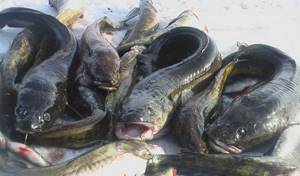
Burbot is considered a fairly valuable commercial fish, since its meat is quite tasty, sweetish in taste and tender. The meat of this predator is characterized by the fact that after freezing or even short-term storage it can quickly lose its taste. Particularly worth noting is the burbot liver, which is quite large in size and characterized by incredible taste and the presence of a whole range of useful components. Burbot meat, like the meat of other representatives of the underwater world, is characterized by low fat content, and therefore is suitable for preparing various dietary dishes.
This is especially true for those who have extra pounds and urgently need to lose them. Burbot dishes, especially boiled ones, are useful for any category of citizens. The only problem is personal intolerance of the body, although there are very few such people. By eating fish dishes every day, a person regularly replenishes his body with the necessary vitamins and microelements. Thanks to this, the functions of many organs, including the central nervous system, are normalized in humans. Moreover, fish dishes prevent aging of the body by rejuvenating the skin. As a rule, diseases appear against the background of a lack of certain microelements, therefore, by consuming fish dishes, it is possible to prevent the occurrence of many ailments in a person.
Interesting Facts
Burbot is a unique species, which in its habits and way of life is very different from other representatives of the ichthyofauna:
- It spawns in winter, when the water temperature drops to 1–3 degrees. At the same time, all other fish become sluggish and passive, but this predator comes to life, feeds heavily, and migrates to spawning areas.
- Goes out hunting at night. In this it is similar to catfish and pike perch. In cloudy weather it can feed during the day.
- Males participate in spawning annually. After spawning, females take a break of 1-2 seasons to recuperate.
- Very prolific. They can lay up to a million eggs per meal.
- Cannibal. Willingly eats its eggs and one-year-old juveniles.
- The pelvic fins, located under the throat, have many small papillae that act as taste buds. This explains why the predator moves along the very bottom, periodically touching it.
- The liver in burbot is highly valued. It is nutritious and non-greasy. Its weight is 8–9% of the total mass of the individual.
This species is loved all over the world. For example, in Alaska it is called the "poor man's lobster." We use it to prepare a variety of dishes that are appreciated by all gourmets.
Is burbot a scavenger or not?
This predatory fish does not disdain carrion. Despite the fact that her diet contains enough live food, she will not swim past a dead carcass or other easily accessible food found at the bottom. That’s why it is often caught on sleeping fry, pieces of meat and lard, liver and offal, defrosted sprat and shrimp are hooked.
How to determine the age of burbot
The main characteristic by which ichthyologists can determine important information about a fish is the size of its scales. But for burbot it does not record the age code. How old the predator is in this situation can be understood by looking at the otoliths - special auditory capsules located in its braincase.
The sizes of otoliths vary between species. Therefore, only ichthyologists and biologists can accurately understand how long the fish lived. An amateur fisherman will not determine the age of a predator on his own. You can only roughly estimate this characteristic by measuring the length and weighing the individual.
Commercial significance
Commercial fishing for burbot is permitted only in the northern regions and only with nets. He is hunted in the Lena, Yenisei, and Ob basins. They fish on the very beds of rivers, in floodplain lakes, reservoirs, numerous channels, and deep pools.
For reference: In the Yenisei basin, burbot catches account for 5–6% of the total annual fish production.
Recreational fishing is allowed in many regions of our country. The best time to fish for a predator is winter. They catch with donks, girders, hooks, and snookers, setting up gear early in the morning, at dusk, or leaving it overnight.
Choosing the optimal tackle and bait for catching burbot
Burbot is the only representative of the cod family in fresh waters.
and the fish prefers flowing reservoirs with cold water; it is distributed throughout Russia. Burbot is called a nocturnal predator; the fish has a sensitive antennae to search for food. Since you have to catch burbot at the very bottom, you need to select the appropriate gear. But it’s even more important to find a body of water where the mustachioed predator lives and calculate its feeding time.
Where to catch burbot
Fishing for burbot is significantly different from all known methods of catching freshwater fish. To catch a spotted bottom predator, you should study the habitats of burbot.
The best place to start looking for fish is in the rivers. There are several signs by which we can conclude that it contains a representative of the cod family.
- If the river is turbulent, has a fast current, and has a rocky, pebble or sandy bottom, then the chance of catching burbot is very high.
- Fish prefers clean water, and if the river flows in the forest far from the bustle of the city, then there are the best places to catch burbot.
The northern rivers, as well as the waterways of Siberia and the Urals, meet all the necessary conditions. Burbot rivers are found in the middle zone, but the problem is that human economic activity has negatively affected the population of this fish. In the slow rivers of the southern regions, which are not distinguished by the purity of their water, it is futile to look for a representative of the cod family.
- To find burbot sites in the river, you need to pay attention to sharp turns. Here you can find steep yars and large pits. And if they contain cold springs or snags, then you can count on a good catch.
- Fish can be found under piers, rafts, and also under floating islands of grass and branches. At great depths, the predator will hide behind rocks, cramps or bottom changes. In northern lakes, burbot comes out to feed on elevations in the form of tables and rocky ridges.
When is the best time to catch fish?
The mysterious way of life of the “freshwater cod” leaves its mark on the fish’s bite. To prevent fishing for strange burbot from turning into a boring pastime on the shore of a reservoir, you need to learn some behavioral factors.
- First of all, you need to remember that the mustachioed predator becomes most active in the cold season. If the water becomes warmer than 12ºС, then the fish hides in the shade, holes or snags. Catching burbot in summer is futile, because the predator hibernates in warm weather.
- The second feature of “freshwater cod” is its nocturnal lifestyle. Even in winter, the fish start biting after dusk. During the day, burbot does not hunt, preferring to rest in underwater shelter.
There are several periods of the year when you can count on a good bite.
- In late autumn, when the nasty rainy weather sets in, the fish have an excellent appetite. The robber especially likes it when the rain is accompanied by a strong wind. Rarely does a fisherman want to spend the night on the shore of a reservoir.
- Burbot feels good even in winter. Before spawning, which takes place in January or February, you can catch a fish feast. An important sign indicating the beginning of spawning is the accumulation of ruff. Probably, the spiny fish is not averse to eating burbot caviar.
Tackle for catching burbot
Fishermen have come up with different ways to catch burbot. Choosing the right one depends on the time of year.
Winter fishing rods
In the northern regions, where a shell of ice covers water bodies most of the year, two gears are used for fishing.
- Zerlitsa are gear known to most winter fishermen for catching predators. In the case of burbot, a number of improvements are made in the equipment.
- Since “freshwater cod” have no teeth, there is no need for a metal leash. There is no point in using a fluorocarbon leader because of the burbot's blindness.
- When installing the girder, it is necessary to clearly determine the depth at the fishing point. The bait should lie on the bottom or be no higher than 3 cm from the bottom surface.
- Before swallowing the bait, burbot likes to hold it in its mouth, savoring the prey. Hooking should be done when the predator is clearly stretching.
- If the angler missed the moment of the bite or left the bets overnight, the hook may end up deep in the fish’s digestive tract. Some people make quick-release leashes, while others find it easier to cut the line. The hook is removed during cleaning. With this method of fishing, the catch-and-release technique cannot be implemented.
- A tackle called a snitch is also popular during the winter burbot fishing season. The fishing rod consists of a short rod with a nod, a reel and a spoon. Instead of a spoon, a jig head or a hook with a sinker can be used. The hook can be equipped with bait of animal origin. Flashing is performed with different amplitudes; there is no need to rush with hooking. Only after a confident blow can you remove the fish onto the ice.
Open water fishing gear
When fishing occurs during the open water season, other gear is used.
- Donka-zakidushka is the simplest but most effective fishing rod. It can be manufactured in different designs. When the tackle is left on a pond, it is best to mount the rig on a piece of thick fishing line or on a nylon cord. A sinker is tied to the end, and 2-3 leashes with a hook are mounted above it. The second end is tied to the root of bushes, trees or to a driven peg. After this, bait is attached to the hooks and casting is performed.
- If an angler wants to be present during fishing, having discovered the habitats of burbot, then it is better to use a rubber bottom. In contrast to the bait, a rubber shock absorber 5-10 m long is tied between the sinker and the main line. The second end of the line is attached to a peg, and a bite alarm is mounted on the stretched line. The tackle is cast only once, after the bite the fish is pulled ashore and a new bait is attached. Under the action of rubber, the equipment is sent to the same place.
- Supporters of sport fishing successfully use a feeder to catch burbot. The English fishing rod is not much different when applied to a mustachioed predator. The same rod with a length of 3.3-3.6 m, the same grinder 2000-3000, the same braided line or monofilament with a breaking force of up to 5 kg, the same Gardner equipment. A distinctive feature will be the use of a luminous signaling device or sound device when fishing at night.
Natural baits and artificial baits
When it becomes clear how to find a burbot site and what gear to choose for fishing, all that remains is to choose a catchable bait. Both natural bait and artificial fish are suitable for fishing. It should be remembered that burbot is a pronounced predator and it is futile to tempt it with plant baits.
Artificial baits
- Ice trolling is most often done using heavy, narrow spoons with a single hook, which is firmly soldered into the body. White and yellow spoons with a length of 5 to 10 cm work best.
- Tandems of two vibrators have proven themselves well. They are attached so that their convex surfaces touch each other. A movable tee is mounted on one of them.
- In Siberian reservoirs, fishermen successfully use wobblers. There is a sliding sinker on the line in front of the bait. Fishing involves periodically releasing and pulling the wobbler. Such fishing is only possible on rivers with a fairly strong current.
Natural baits
The choice of bait is largely determined by the season of the year. It is not always possible to find animal bait that is attractive to fish.
- During the open water season, it is possible to seduce “freshwater cod” with a bunch of dung worms. In their absence, you can also use earthen relatives, but before casting it is recommended to dip them in a flavoring agent.
- Burbot loves live bait, which is required to equip the girder. The mustachioed gourmet is especially partial to ruffs.
- In the absence of live bait, you can use sliced fresh or salted fish. Even canned seafood is used.
- Frogs or their meat fried over a fire are considered good bait.
- In those reservoirs where there is a lot of shell rock, you should tempt the predator with pearl barley meat.

